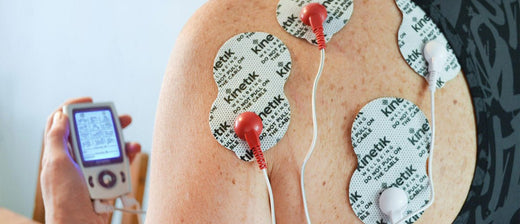Sciatica is a common pain condition and up to 40% of the UK population will suffer from it at some point. Dr Katie Stephens offers advice on managing Sciatica pain.
What is Sciatica?
The Sciatic Nerve travels from the lower spine (L4 – S3) down the buttock and along the back of the thigh. Behind the knee, it branches into more nerves that move down the lower leg and into the foot. It can be quite common for an issue in the lower back (say, some wear and tear in the bones of the spine) to irritate the sciatic nerve and cause pain along its path. While the pain may be severe, some measures can help.
If you have new back pain with any of the following: numbness around the back passage or genital region, new difficulty controlling your bowels or bladder, or a new muscular weakness in the legs, this suggests a potential emergency, and I would advise getting yourself to A&E immediately.
For other back pain, if you have any other concerning symptoms, such as unexpected weight loss, night sweats, pain that regularly wakes you at night, or if you have a history of cancer that can spread to a bone, and if the pain just doesn’t seem to be improving as you’d expect, please speak to your GP.
For anyone who has been diagnosed with sciatica, I hope you find this article helpful in managing your pain better.
Tips for managing Sciatica Pain
There are a variety of options for improving pain and reducing functional restrictions in sciatica1.
These range from conservative measures, such as physiotherapy and generally staying active (the importance of staying active and avoiding resting in bed is not to be underestimated!), to medication (simple painkillers from over the counter can help, and of course, there are stronger options such as specific nerve-targeting medication available on prescription). At the top end are the more invasive measures such as steroid injections and spinal surgery.
The focus of this article, however, is on how using a TENS machine may help.
What is TENS?
TENS stands for Transcutaneous (meaning ‘through the skin’) Electrical Nerve Stimulation – quite a mouthful! TENS machines are small electrical devices with pads that stick on to your skin. They are commonly used to treat pain stemming from a variety of causes, such as period pains, arthritis and musculoskeletal injuries.

How does TENS work?
The sticky pads that attach to your skin are electrodes. When the machine is turned on, pulses of electrical current are delivered via these pads. It is thought that this electrical signalling can interfere with the way the local nerves are communicating pain to the brain, effectively reducing the feeling of pain and promoting relaxation of local muscles. They may also stimulate endorphin production, which can have a further impact on pain reduction2,3.
The Kinetik Wellbeing Dual-Channel TENS machine
Find out more about the Kinetik Wellbeing Dual-Channel TENS machine here. Supplied to the NHS, clinically validated and your perfect choice for easy to use at home drug-free pain relief.
Can TENS reduce pain for sciatica patients?
In a word, yes. While it remains a somewhat controversial subject, there is evidence that the use of TENS can reduce pain intensity in people with both acute and chronic pain compared to using a placebo4. Additionally, there is evidence specific to its use in people with sciatica, which suggests TENS use may reduce (although not eliminate) the severity of pain that someone with sciatica feels5.

What are the benefits of using TENS for sciatica patients?
The primary research on the benefits of using TENS focuses on whether or not it reduces pain, so I would loath to declare any other benefits definitively without evidence to back this up. We could make a logical argument, however, that if someone’s pain improves, they may also see further benefits as a result of this. For instance, if someone’s pain has stopped them from being able to do things or move around as much as they’d like, we would hope that a reduction in pain intensity may have a knock-on effect of improving mobility and functionality.
TENS Digital Pain Relievers
Kinetik Wellbeing TENS Digital Pain Relievers are designed as a safe and easy way of relieving everyday pain. The multiple stimulations and intensity settings allow you to customise managing your pain relief for different parts of your body and pain.
More information about living well
For more information about lower back pain and sciatica, please check out these useful leaflets from patient.info6,7, or dig into some of the references I’ve listed in the references below.
Sciatica can cause pain, weakness and numbness in the legs, which in turn can make balance and mobility more challenging. This can increase the risk of falling and affect confidence. The pain associated with sciatica can sometimes restrict mobility too, making it difficult to reach a phone or get help in an emergency. Many older adults with sciatica feel reassured with a fall alarm or personal alarm so they can call for assistance easily with an emergency button.
Top tips for sleeping with Sciatica
A good night's sleep is a significant component of effective sciatica treatment. However, when you’re in pain, finding a comfortable sleeping position that allows for a restful night's sleep can be easier said than done.
References
- https://www.nhs.uk/conditions/sciatica/
- https://www.nhs.uk/conditions/transcutaneous-electrical-nerve-stimulation-tens/
- Vance, C. G., Dailey, D. L., Rakel, B. A., & Sluka, K. A. (2014). Using TENS for pain control: the state of the evidence. Pain management, 4(3), 197–209. https://doi.org/10.2217/pmt.14.13
- Johnson MI, Paley CA, Jones G, et al Efficacy and safety of transcutaneous electrical nerve stimulation (TENS) for acute and chronic pain in adults: a systematic review and meta-analysis of 381 studies (the meta-TENS study) BMJ Open 2022;12: https://doi.org/10.1136/bmjopen-2021-051073
- Krumme, T. G., Weinmann, A. Is TENS effective for reducing neuropathic pain? Evidence-Based Practice Feb 2020. Volume 23 - Issue 2 - p 37. https://doi.org/10.1097/EBP.0000000000000565
- https://patient.info/bones-joints-muscles/back-and-spine-pain/lower-back-pain
- https://patient.info/bones-joints-muscles/back-and-spine-pain/slipped-disc-prolapsed-disc
Advice to help you talk about care options

Talking about elderly care early improves health and wellbeing. That's why we're encouraging family carers to #HaveTheTalk by offering personalised guidance to help you have an open and honest discussion about care options and personal alarms.





